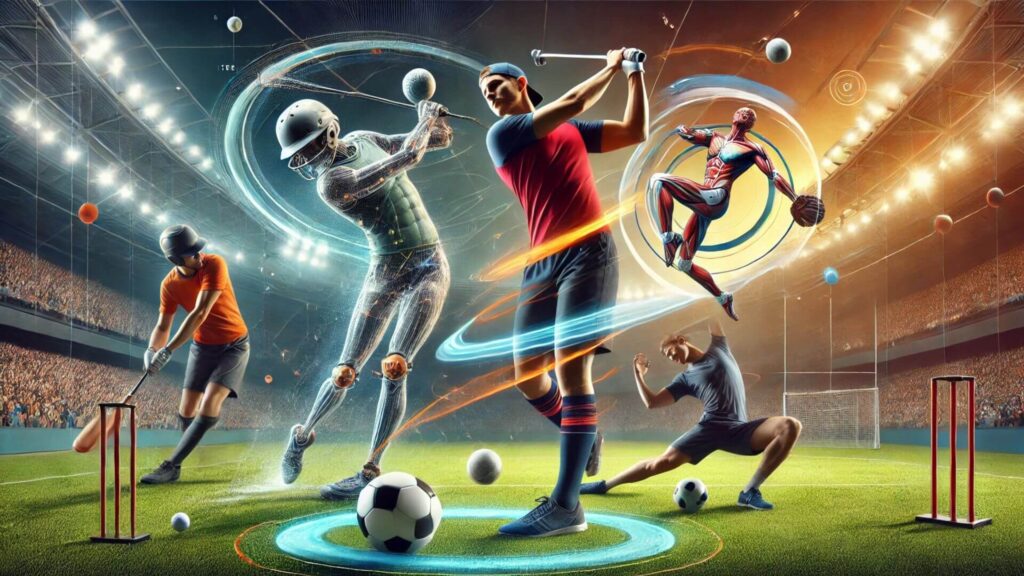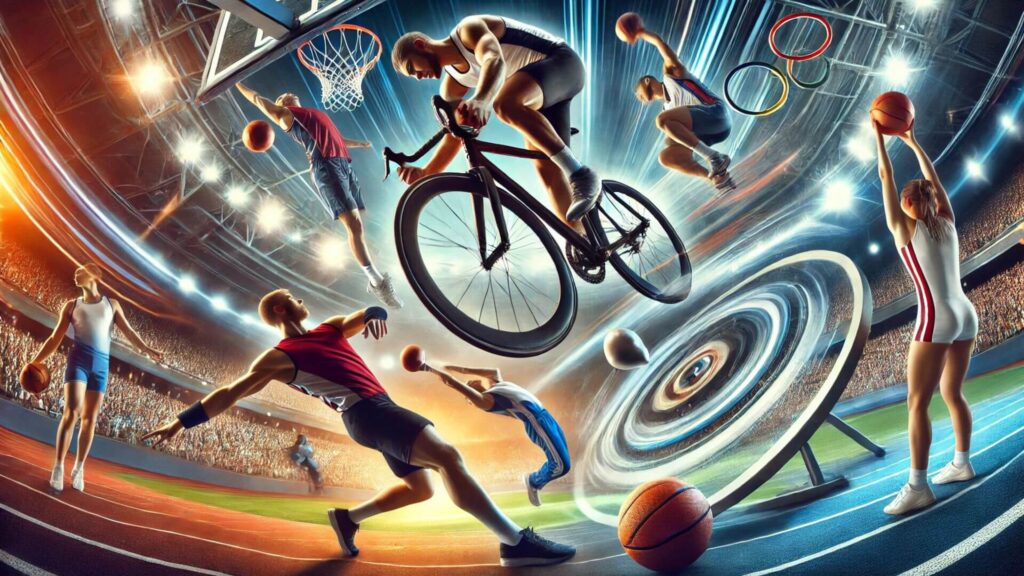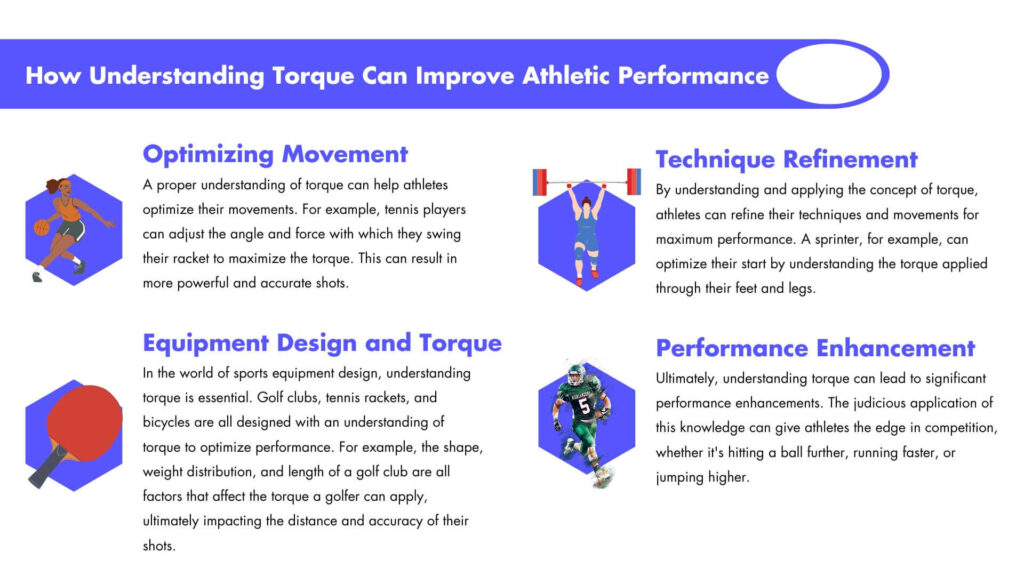The world of sports often features physical prowess at the forefront. However, understanding the science behind the game can provide a distinctive edge over the competition. One such concept that is pivotal yet often overlooked is ‘torque.’ At its core, torque—a term rooted in physics and kinesiology—represents the rotational force that impacts an object.
Torque plays a critical role in various sports and the design of their equipment, including golf clubs, tennis rackets, and bicycles. This article aims to shed light on the concept of torque, its application in sports kinesiology, and why its understanding is indispensable for athletes.
Table of Contents
ToggleThe Role of Torque in Sports: An Overview

Torque, also known as moment or moment of force, can be understood as the measure of the force that can cause an object to rotate about an axis. It is calculated as the product of the force applied and the distance from the pivot point at which the force is applied.
In the context of sports, torque helps to:
- Generate power and speed in rotational movements, like a golfer’s swing or a cyclist’s pedal stroke.
- Control the direction and trajectory of sports equipment, such as a tennis racket or a baseball bat swing.
- Balance and stability during movements, for instance, a gymnast’s rotation on the parallel bars.
- Enhance precision during the execution of sports techniques, such as the angle at which a soccer player kicks the ball for a curved trajectory.
- Optimize sports equipment design, allowing manufacturers to adjust factors like weight distribution and stiffness to improve performance and reduce the risk of injury.
- Increase efficiency in energy transfer; for example, during the downstroke in cycling, the application of torque can help transfer more power from the cyclist to the bike, thereby enhancing overall performance.
- Improve accuracy and precision in sports like archery or shooting, where the torque of the bow or gun can significantly affect the trajectory and final placement of the arrow or bullet.
- Enhance endurance and fatigue management in high-intensity sports such as rowing or long-distance cycling, where understanding and manipulating torque can help athletes pace their energy expenditure more efficiently.
- Enable more effective training, as athletes can adjust their technique based on their understanding of torque to achieve specific goals, such as increasing their throwing distance or improving their swing speed.
- Facilitate recovery and injury prevention, as understanding the concept of torque can help athletes to better appreciate the forces at play during their sporting activities and hence adopt techniques that minimize unnecessary strain on their bodies.
Torque in Sports Equipment Design
Torque plays a significant role in the design of sports equipment. An understanding of torque can lead to the creation of more efficient designs, enhancing athletic performance. Here’s how torque comes into play in the design of various sports equipment:
- Golf Clubs: A golf club’s design and weight distribution are critical to creating the optimal amount of torque during a swing. This torque directly affects the distance and direction the golf ball will travel.
- Tennis Rackets: The application of torque principles allows for the design of tennis rackets that maximize swing speed and control. Additionally, understanding torque can help players adjust their grip and swing angle to optimize their shot.
- Bicycles: In cycling, torque relates to the force a rider applies to the pedals. The design of the pedals, crank arms, and gears can significantly affect the torque produced, thus influencing the bicycle’s speed and the rider’s efficiency.
- Baseball Bats: The mass distribution in a baseball bat impacts the torque a player can generate with each swing. An adequately designed bat can increase hitting power, control, and speed, making every swing more effective.
- Archery Bows: Torque comes heavily into play in the design of archery bows. The draw weight and how the energy is stored and released when the arrow is shot can significantly influence the arrow’s speed and trajectory. Understanding torque can help archers choose the right bow for their style and improve their shooting accuracy.
Kinesiology and Torque: How Do They Interact?

Kinesiology, the study of human movement, extensively deals with torque since many physical activities involve some form of rotation. Understanding this interplay can greatly enhance an athlete’s performance and prevent potential injuries. Here are some ways in which kinesiology and torque interact:
The Physics of Human Movement
Every joint in our body acts as a pivot or axis, and the muscles provide the force necessary for movement, thus creating torque. For example, when a basketball player takes a shot, the elbow acts as the axis, and the muscles in the arm apply the force to create the torque for the throw.
The Role of Leverage
Leverage, a principle very closely linked with torque, plays a significant role in the movement of our bodies. Longer limbs can produce greater torque (since torque is the product of force and distance), allowing for more powerful movements. For example, long-legged runners can cover larger distances in a single stride, and basketball players with longer arms can easily shoot baskets.
Force Distribution and Injury Prevention
Understanding torque also helps in preventing injuries. By understanding how force is distributed across various joints and muscles, athletes can avoid overloading certain areas and minimize the risk of injury. For instance, cyclists who understand the concept of torque can adjust their pedaling technique to distribute force more evenly and prevent knee issues.
The Contribution to Training and Rehabilitation
Knowledge of torque is also beneficial during training and rehabilitation. Coaches and physical therapists can design training regimes or recovery exercises by considering the torque that would be produced. It aids in developing strength, improving technique, and speeding up recovery.
Enhancing Athletic Performance
Kinesiology’s understanding of torque can help athletes enhance their performance. By knowing how much force to apply and the angle at which to apply it, athletes can maximize the torque they generate, improving the effectiveness of their movements. For instance, golfers can achieve longer drives, swimmers can improve stroke efficiency, and sprinters can increase speed.
The Impact of Torque on Athlete’s Body
Athletes go through a lot of physical stress due to the constant torque they apply to their bodies. The intensity and duration of activities can lead to significant strain on joints, muscles, and tendons. Repetitive use can result in chronic injuries such as tendonitis or bursitis.
Muscular Strain and Torque
Overexertion and incorrect application of torque can lead to muscular strain. Athletes should be mindful of the force they apply and the angle at which they use it to avoid overstressing their muscles. Key points include:
- A baseball pitcher generating high torque on their throwing arm can risk injury if they overstrain their muscles.
- Cyclists producing high torque on the pedals over a prolonged period can lead to muscle fatigue and strain.
Impact on Joints
The torque generated by athletes greatly impacts their joints. This can be beneficial and harmful, depending on the degree and direction of the force. Examples include:
- Weightlifters use the concept of torque to their advantage to lift heavy weights while minimizing the impact on their joints.
- However, repeated high-torque impacts on the same joints (such as the knee joint in runners or the shoulder joint in tennis players) can lead to wear and tear over time.
Potential for Injuries
Applying torque incorrectly or excessively can lead to injuries. Here are a couple of examples:
- In golf or baseball, improper rotation or torque can lead to injuries like a golfer’s elbow or pitcher’s shoulder.
- Gymnasts and dancers who perform high-torque movements are at risk for injuries if they lack proper training or do not execute the movements correctly.
Importance of Training and Conditioning
To mitigate the potential negative impacts of torque on the body, athletes should engage in appropriate training and conditioning. This includes:
- Strength training to build the muscular power needed to generate and withstand the forces involved.
- Technique training to ensure that athletes apply torque in the most effective and safest manner.
- Regular conditioning ensures the body is prepared for the stresses of their specific sport.
How Understanding Torque Can Improve Athletic Performance
The concept of torque is not just about managing the physical strain and risks associated with sports performance; it also plays a key role in enhancing an athlete’s performance. When athletes understand how torque works and how it can be manipulated, they can optimize their actions for maximum effect.

Optimizing Movement
A proper understanding of torque can help athletes optimize their movements. For example, tennis players can adjust the angle and force with which they swing their racket to maximize the torque. This can result in more powerful and accurate shots.
Equipment Design and Torque
In the world of sports equipment design, understanding torque is essential. Golf clubs, tennis rackets, and bicycles are all designed with an understanding of torque to optimize performance. For example, the shape, weight distribution, and length of a golf club are all factors that affect the torque a golfer can apply, ultimately impacting the distance and accuracy of their shots.
Technique Refinement
By understanding and applying the concept of torque, athletes can refine their techniques and movements for maximum performance. A sprinter, for example, can optimize their start by understanding the torque applied through their feet and legs.
Performance Enhancement
Ultimately, understanding torque can lead to significant performance enhancements. The judicious application of this knowledge can give athletes the edge in competition, whether it’s hitting a ball further, running faster, or jumping higher.
Measure Torque with DATAMYTE
DATAMYTE, a recognized industry leader in providing robust data collection and quality management solutions, offers a range of torque products designed to enhance accuracy and efficiency in various manufacturing environments.
LightStar™ Torque Wrench
This precise torque-measuring instrument is designed to eliminate false readings that are difficult to detect. The LightStar™ Torque Wrench series technology sensor ensures that the operator can pull at any point on the wrench and will receive an accurate measurement.
DataMyte Torque Solution
This solution provides real-time reporting and torque data collection to improve and monitor torque continuously. It’s a comprehensive system for managing all aspects of torque control, from data collection to analysis and reporting.
New Generation of Digital Torque Wrenches
DATAMYTE has introduced a new generation of their LightStar™ Carbon Fiber Torque Wrench. These digital torque wrenches offer improved performance and accuracy, making them ideal for demanding industrial applications.
These products are part of DATAMYTE’s commitment to providing quality management solutions that enhance actionable results based on collected production data. They are designed to ensure consistent, reliable torque application, improving the quality and reliability of assembled products. Book a demo with us now to see how we can help you achieve your torque accuracy goals.
Conclusion
Understanding and effectively applying the concept of torque is crucial for athletes, not only for minimizing injury risk but also for enhancing performance. Additionally, this understanding influences the design of sports equipment, further amplifying the impact of torque on athletic performance. So, take the necessary steps to understand torque kinesiology and its application.



